Showing Spotlights 425 - 432 of 2790 in category All (newest first):
 Researchers demonstrate that dust-sized photovoltaic cells grown on silicon substrate can be heterogeneously integrated with other chiplets using a high-throughput wafer-level packaging process. The ability to integrate various nanoelectronic chiplets - such as processor, memory, and photovoltaics - in an industrial-scale wafer-level-packaging process, unlocks the potential of large-scale manufacturing of these compact integrated systems with high performance and ultralow cost.
Researchers demonstrate that dust-sized photovoltaic cells grown on silicon substrate can be heterogeneously integrated with other chiplets using a high-throughput wafer-level packaging process. The ability to integrate various nanoelectronic chiplets - such as processor, memory, and photovoltaics - in an industrial-scale wafer-level-packaging process, unlocks the potential of large-scale manufacturing of these compact integrated systems with high performance and ultralow cost.
Oct 27th, 2020
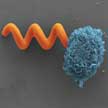 The immune system's activation of macrophages, a type of immune cells that are on the lookout for pathogens, is a major obstacle for developing functional medical microrobots that can operate in vivo for a prolonged period of time. Researchers are trying to overcome this challenge by 'camouflaging' therapeutic nanoparticles with special coatings so that they avoid detection by macrophages. In new work, researchers report the development of stealth microrobots that can fly under the radar of the immune system, and hence prolong their window of operation since they do not get eliminated.
The immune system's activation of macrophages, a type of immune cells that are on the lookout for pathogens, is a major obstacle for developing functional medical microrobots that can operate in vivo for a prolonged period of time. Researchers are trying to overcome this challenge by 'camouflaging' therapeutic nanoparticles with special coatings so that they avoid detection by macrophages. In new work, researchers report the development of stealth microrobots that can fly under the radar of the immune system, and hence prolong their window of operation since they do not get eliminated.
Oct 26th, 2020
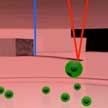 Atomic force microscopy (AFM) is one of the newer techniques available for virus research. AFM is a cantilever-based technique that utilizes a sharp tip to interrogate surfaces at resolutions well below the optical diffraction limit. Beyond imaging, AFM is also a powerful tool for nano-mechanical probing and nano-manipulation. One of the primary advantages of AFM is that it can operate on samples immersed in liquid. This empowers experiments on living cells at physiologically relevant conditions.
Atomic force microscopy (AFM) is one of the newer techniques available for virus research. AFM is a cantilever-based technique that utilizes a sharp tip to interrogate surfaces at resolutions well below the optical diffraction limit. Beyond imaging, AFM is also a powerful tool for nano-mechanical probing and nano-manipulation. One of the primary advantages of AFM is that it can operate on samples immersed in liquid. This empowers experiments on living cells at physiologically relevant conditions.
Oct 23rd, 2020
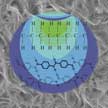 Being able to replicate the extraordinary mechanical properties of nacre and other biological structures could lead to synthetic materials that possess the exceptional mechanical properties required to perform under extreme conditions. In this context, ultrahigh molecular weight polyethylene is a high-performance specialty polymer with a unique set of properties and applications. It shows remarkable strength-to-weight ratio and an excellent energy absorption ability, making it a promising material for protective applications such as body armor, biomedical implants or heat-resistant coatings.
Being able to replicate the extraordinary mechanical properties of nacre and other biological structures could lead to synthetic materials that possess the exceptional mechanical properties required to perform under extreme conditions. In this context, ultrahigh molecular weight polyethylene is a high-performance specialty polymer with a unique set of properties and applications. It shows remarkable strength-to-weight ratio and an excellent energy absorption ability, making it a promising material for protective applications such as body armor, biomedical implants or heat-resistant coatings.
Oct 22nd, 2020
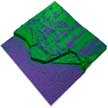 Kelvin probe force microscopy (KPFM), also known as surface potential microscopy, is one member of a suite of electrical characterization methods available in atomic force microscopes. It maps the contact potential difference between a surface and the cantilever, containing information about the surface potential and work function. KPFM is a surface-sensitive method that probes at and near the surface only. It is often used as a qualitative technique to obtain contrast based on the surface potential.
Kelvin probe force microscopy (KPFM), also known as surface potential microscopy, is one member of a suite of electrical characterization methods available in atomic force microscopes. It maps the contact potential difference between a surface and the cantilever, containing information about the surface potential and work function. KPFM is a surface-sensitive method that probes at and near the surface only. It is often used as a qualitative technique to obtain contrast based on the surface potential.
Oct 21st, 2020
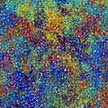 Researchers have recently demonstrated that high-intensity focused ultrasound (HIFU) is a promising, non-invasive stimulus with multiple superior and unique capabilities to induce localized heating and achieve temporal and spatial thermal effects in polymers. The team proposes a new manner of stimulating stimuli-responsive polymers. These polymers demonstrate promise for controlled drug delivery, sensing and biosensing, smart coatings, soft robotics, and flexible electronics among others.
Researchers have recently demonstrated that high-intensity focused ultrasound (HIFU) is a promising, non-invasive stimulus with multiple superior and unique capabilities to induce localized heating and achieve temporal and spatial thermal effects in polymers. The team proposes a new manner of stimulating stimuli-responsive polymers. These polymers demonstrate promise for controlled drug delivery, sensing and biosensing, smart coatings, soft robotics, and flexible electronics among others.
Oct 20th, 2020
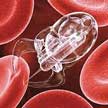 The ability to communicate new advances in science and technology has never been more important, and in that regard innovations with nanotechnology are growing more rapidly than ever with benefits to both society and the economy. However, for many consumers and the general public, the very idea of nanotechnology is both a wonder and an enigma. But how do we keep our society engaged with new nanotechnology at a time when everyone is more discerning? Well, one approach is to use storytelling.
The ability to communicate new advances in science and technology has never been more important, and in that regard innovations with nanotechnology are growing more rapidly than ever with benefits to both society and the economy. However, for many consumers and the general public, the very idea of nanotechnology is both a wonder and an enigma. But how do we keep our society engaged with new nanotechnology at a time when everyone is more discerning? Well, one approach is to use storytelling.
Oct 15th, 2020
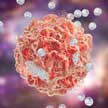 The use of graphene-based materials in pharmaceutical nanotechnology has recently received more attention due to their unique chemical structure and physicochemical properties - including an ultra-high surface area, optical, thermal and electrical conductivities, and a good biocompatibility. They can also load large amounts of drug molecules on both sides of the single atom layer sheet. The next generation of cancer nanotheranostics employing graphene-based nanomaterials could address the many challenges associated with traditional chemotherapeutic agents, such as the issues surrounding poor solubility, harmful side effects, non-specific drug distribution, and multi-drug resistance.
The use of graphene-based materials in pharmaceutical nanotechnology has recently received more attention due to their unique chemical structure and physicochemical properties - including an ultra-high surface area, optical, thermal and electrical conductivities, and a good biocompatibility. They can also load large amounts of drug molecules on both sides of the single atom layer sheet. The next generation of cancer nanotheranostics employing graphene-based nanomaterials could address the many challenges associated with traditional chemotherapeutic agents, such as the issues surrounding poor solubility, harmful side effects, non-specific drug distribution, and multi-drug resistance.
Oct 9th, 2020
 Researchers demonstrate that dust-sized photovoltaic cells grown on silicon substrate can be heterogeneously integrated with other chiplets using a high-throughput wafer-level packaging process. The ability to integrate various nanoelectronic chiplets - such as processor, memory, and photovoltaics - in an industrial-scale wafer-level-packaging process, unlocks the potential of large-scale manufacturing of these compact integrated systems with high performance and ultralow cost.
Researchers demonstrate that dust-sized photovoltaic cells grown on silicon substrate can be heterogeneously integrated with other chiplets using a high-throughput wafer-level packaging process. The ability to integrate various nanoelectronic chiplets - such as processor, memory, and photovoltaics - in an industrial-scale wafer-level-packaging process, unlocks the potential of large-scale manufacturing of these compact integrated systems with high performance and ultralow cost.
 Subscribe to our Nanotechnology Spotlight feed
Subscribe to our Nanotechnology Spotlight feed





